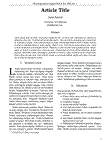Resultados de búsqueda - (migue OR (sigue OR (migne OR ((min OR line) OR amine)))) 1
Materias dentro de su búsqueda.
Materias dentro de su búsqueda.
- Estudiantes 3
- Scrap 3
- 2
- 5 why 2
- Aprendizaje 2
- Caos 2
- Chaos 2
- Covid-19 2
- Educación 2
- Equifinalidad 2
- Equifinality 2
- Estrategia 2
- Estratificación 2
- Estructura 2
- Exclusión 2
- I21 2
- Ishikawa diagram 2
- L. vannamei 2
- Mexico 2
- Pandemia 2
- Pandemic 2
- Pareto Diagram 2
- Quality Rate 2
- Sistemas 2
- Situacional 2
- Situational 2
- Strategy 2
- Structure 2
- Students 2
- Trabajo 2
-
261
Efecto de la aplicación de Dinoprost Trometamina (Lutalyse) sobre el comportamiento sexual en carneros jóvenes
Publicado 2021“…El estudio se realizó con 24 carneros Saint Croix (16,1 ± 1,1 meses), que fueron asignados a dos tratamientos. …”
Enlace del recurso
Tesis -
262
Enzymatic Potential of Native Fungal Strains of Agave Residues
Publicado 2017“…Our previous studies showed that the expression of orexin was decreased in mice carrying null-mutations of the transcription factor early B-cell factor 2 (ebf2) and that the promoter region of the prepro-orexin (Hcrt) gene contained two putative ebf-binding sites, termed olf‑1 sites. In the present study, a minimal promoter region of the murine Hcrt gene was identified, which was able to drive the expression of a luciferase reporter gene in the human 293 cell line. …”
Enlace del recurso
Artículo -
263
Evaluación de la terapia con temozolomida, panobinostat y extracto de Lophophora williamsii en la inducción de muerte inmunogénica en un modelo murino de glioma
Publicado 2020“…The heat shock proteins (HSP) 70, HSP90 and high mobility group box 1 (HMGB1) were identified by ELISA. In vivo tests were performed in a rat model using the C6 cell line. …”
Enlace del recurso
Tesis -
264
Evaluación de la terapia con temozolomida, panobinostat y extracto de Lophophora williamsii en la inducción de muerte inmunogénica en un modelo murino de glioma
Publicado 2020“…The heat shock proteins (HSP) 70, HSP90 and high mobility group box 1 (HMGB1) were identified by ELISA. In vivo tests were performed in a rat model using the C6 cell line. …”
Enlace del recurso
Tesis -
265
-
266
-
267
-
268
-
269
-
270
-
271
-
272
-
273
Hairy cell leukemia, an uncommon B-cell lymphoid neoplasia
Publicado 2016“…In addition, a bone biopsy is useful to perform an immunohistochemistry analysis for TRAP, DBA-44 and A1 annexin. Purine analogues remain the first line of treatment. …”
Enlace del recurso
Artículo -
274
-
275
-
276
Synthesis, characterization, and growth simulations of Cu–Pt bimetallic nanoclusters
Publicado 2014“…Analysis of transmission electron microscopy (TEM) and spherical aberration (Cs)-corrected scanning transmission electron microscopy (STEM) images shows that the average diameter of the Cu–Pt nanoclusters is 3.0 ± 1.0 nm. The high angle annular dark field (HAADF-STEM) images, intensity profiles, and energy dispersive X-ray spectroscopy (EDX) line scans, allowed us to study the distribution of Cu and Pt with atomistic resolution, finding that Pt is embedded randomly in the Cu lattice. …”
Enlace del recurso
Artículo -
277
-
278
Prevalencia de la hipoglucemia y costos relacionados a su atención en un hospital de tercer nivel.
Publicado 2018“…La edad promedio fue de 61±7 años, 58% mujeres y el tiempo de evolución de la diabetes fue de 14±9 años. 83 % ingresaron por hipoglucemia severa y 17 % no severa Uso de sulfonilureas (SU) representó la principal causa de hipoglucemia (53%), seguido de insulina (19%), insuficiencia suprarrenal (2%), insulinoma (1%), sin especificarse la causa en 25%. El 61% de los pacientes con TFG ≤30 ml/min se encontraban con SU al momento del ingreso. …”
Enlace del recurso
Tesis -
279
Prevalencia de la hipoglucemia y costos relacionados a su atención en un hospital de tercer nivel.
Publicado 2018“…La edad promedio fue de 61±7 años, 58% mujeres y el tiempo de evolución de la diabetes fue de 14±9 años. 83 % ingresaron por hipoglucemia severa y 17 % no severa Uso de sulfonilureas (SU) representó la principal causa de hipoglucemia (53%), seguido de insulina (19%), insuficiencia suprarrenal (2%), insulinoma (1%), sin especificarse la causa en 25%. El 61% de los pacientes con TFG ≤30 ml/min se encontraban con SU al momento del ingreso. …”
Enlace del recurso
Tesis -
280


